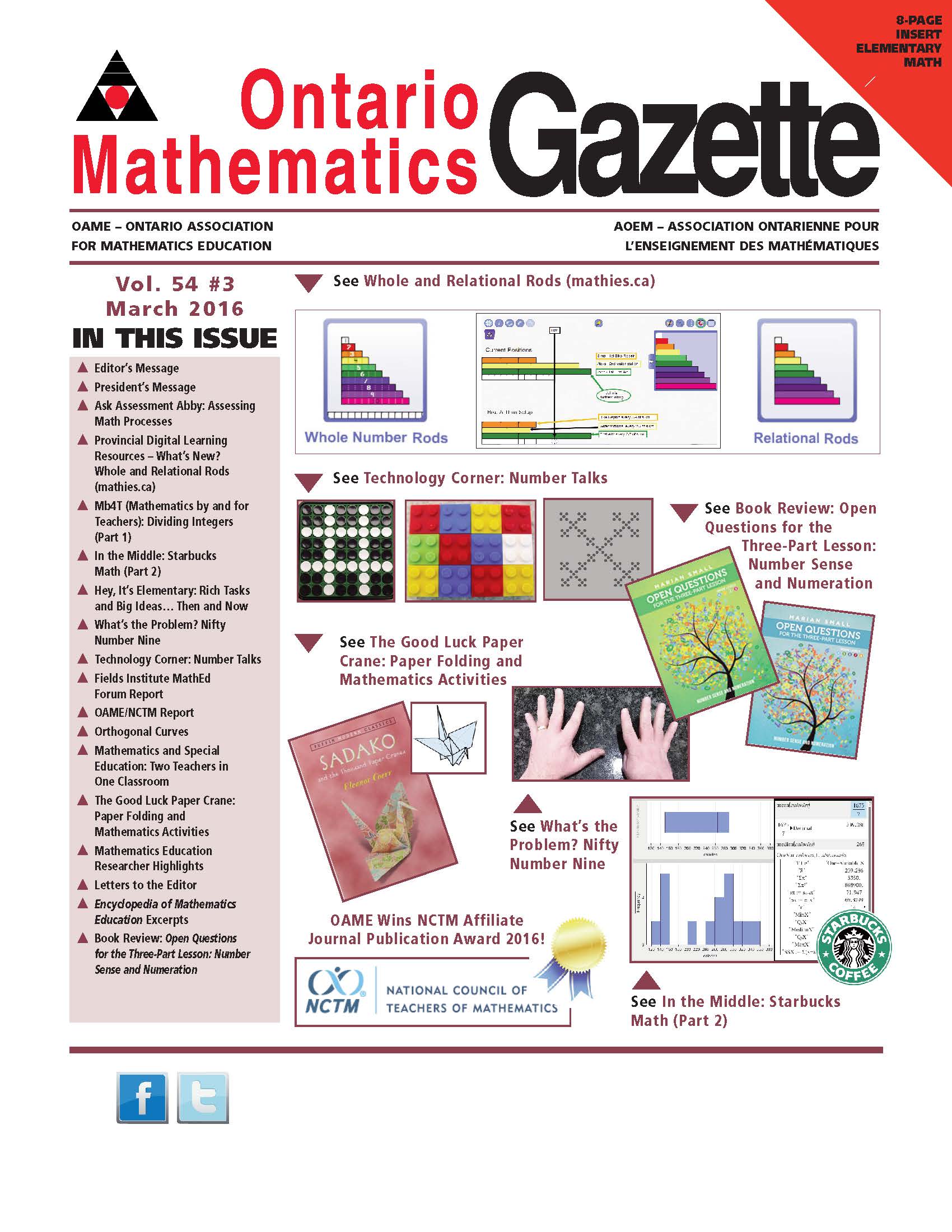OAME Gazette Volume 54 Number 3 released including  three articles, ten regular columns, the Abacus insert focusing on the elementary panel, along with several other special features.
three articles, ten regular columns, the Abacus insert focusing on the elementary panel, along with several other special features.
Betty Long and Deborah Crocker in their article, The Good Luck Paper Crane: Paper Folding and Mathematics Activities, provide directions for folding paper cranes, and ideas for mathematics activities using the paper cranes and children’s literature. Specifically, the authors highlight the touching story of Sadako Sasaki, the Japanese girl who was exposed to radiation from the atomic bomb dropped on Hiroshima during World War II, and who subsequently attempted to fold 1000 paper cranes in order to obtain her secret wish (Coerr, 2004).
In Mathematics and Special Education: Two Teachers in One Classroom, Jacob Speijer, Connie Gray, Sandra Peirce, and Gail Doherty present the results of a board-wide professional learning project for which the primary aim was to leverage the complementary instructional strengths of the regular classroom teacher (RCT) and the special education resource teacher (SERT) within the classroom context. Anticipated benefits (reduced stigmatization, mathematics program integrity, increased opportunities for individual help, and greater differentiated instruction and assessment) and observed program results are discussed at length, as are recommendations for future implementation of similar programming, based on their co-teaching experiences.
Meth Devendra, building upon one of his previous and related Gazette articles (exponential functions and tangents, V54N1), provides algebraic, geometric, and practical examples of Orthogonal Curves, i.e., the situation where the tangent lines to two curves at the point of intersection are perpendicular.
Regular columns include the following highlights: OAME President, Tim Sibbald (President’s Message) discusses the numeracy–literacy connection, and draws attention to two new books by authors Roberts (re. Conway’s mathematical contributions) and Angus (re. Attawapiskat and social justice issues, including education); Todd Romiens (OAME/NCTM Report) addresses the controversy surrounding the American Common Core State Standards for Mathematics (CCSSM), specifically highlighting the mathematical content standards and mathematical practices (process standards); Shawn Godin (What’s the Problem?) explores the “nifty number 9” including finger multiplication; Assessment Abby (eponymous) focuses on assessment of the Mathematical Process expectations; and Markus Wolski, Agnes Grafton, Ross Isenegger, Greg Clarke, and Kathleen Corrigan (Provincial Digital Learning Resources) describe the “Whole and Relational Rods” tool designed to help students explore number concepts, develop reasoning for various operations, and foster proportional reasoning skills.
Ann Kajander (MB4T) looks at teaching and learning strategies for introducing the first two of the four possible cases of dividing integers. Lynda Colgan (Hey, It’s Elementary) discusses rich tasks, big ideas, and a classroom activity in which students analyzed Northern Ontario bear family composition statistics as compared with those of humans; Mary Bourassa (Technology Corner) explores Number Talks, introducing two rich online resources created by Tranchmontagne (Number Talk Images) and Nguyen (Math Talk); and Carly Ziniuk (In the Middle) presents the second part of Starbucks’ Math in which she focuses on data analysis activities using technology. In the Abacus insert, co-editors Mary Lou Kestell and Kathy Kubota-Zarivnij continue their Volume 54 focus on relational thinking, here focusing on multiplication.
Volume 54 Issue 3 also includes several special features: (i) a letter to the editor by Louis Lim in which he pays personal tribute to the late Frances Schatz; (ii) a review of the 2-volume book set entitled Open Questions for the Three-Part Lesson: Number Sense and Numeration (2015) by author Marian Small; (iii) several Ontario mathematics education researcher profile highlights; and, (iv) further excerpts from Lerman’s Encyclopedia of Mathematics Education (2014) regarding a variety of contemporary math education issues.
